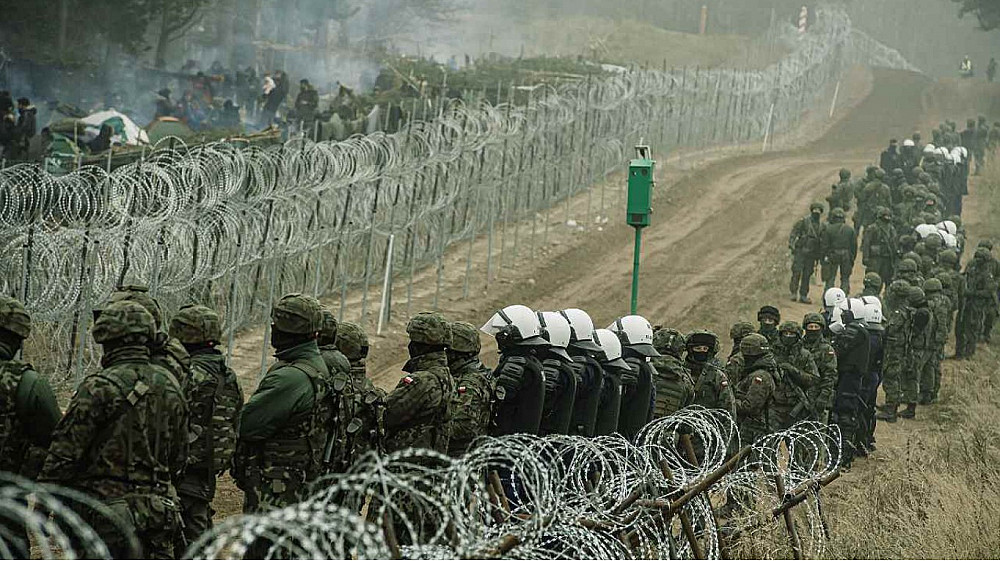Three crises along Russia’s borders offer an insight into how the Kremlin tries to translate turbulence into geopolitical profit.
From Belarus to Ukraine to Georgia, an arc of instability has emerged, offering opportunities for malign activities by foreign powers. This has proved too tempting for Vladimir Putin’s Russia, which openly pursues an activist foreign policy seeking gains for the Kremlin at whatever cost to its neighbors. For the West, it is time to consider the wider Black Sea region as a whole and to develop a strategy.
The migrant crisis unfolding on the Belarusian-Polish border is the most pressing and serious emergency. For some months, the Belarus dictator Aliaksandr Lukashenka and his security services have been funneling thousands of Middle Eastern migrants toward the EU border. Officially, Russia has distanced itself from the crisis, with President Vladimir Putin on November 13 denying claims he had helped to orchestrate a crisis.
Russia is often disbelieved by neighbors with unhappy experiences of its statecraft. In this case, too, there are reasons to doubt Putin’s words. Firstly, the Belarus migrant drama bears an uncanny resemblance to the events of 2016, when the Kremlin unleashed a sudden wave of developing world migrants across Finland’s and Norway’s Arctic borders. Secondly, few believe Lukashenka’s regime on its own is sufficiently organized to orchestrate events of complexity spanning two continents.
Russia’s rapid dispatch of advanced combat aircraft and paratroopers (two of whom died in the exercise) to the Belarus-Poland border and Putin’s contemptuous dismissal of Germany’s Chancellor and the EU’s senior head of government Angela Merkel (she was told to call Lukashenka herself) were open signals of approval for the Belarusian position. Only when Lukashenka mused that he might cut off gas supplies to Europe was he publicly slapped down by Russia. It was also notable that Russia and Belarus recently agreed on further steps in their on-again-off-again Union state.
To the south, in eastern Ukraine, the clouds are also gathering. Fighting is worsening with Russia’s separatists in Donbas, and ceasefire violations are spiking. US briefings now suggest around 100,000 military personnel and large amounts of armored equipment are located within reach of the border; military movements are being organized at night. Not only does this follow the deployment of large Russian formations for exercises in the Spring, but it also matches a threatening drumbeat of anti-Ukrainian rhetoric from Russian leaders including Putin, who have questioned the country’s right to an independent existence. The Kremlin has increased funding for the Donbas and pledged humanitarian support to the rebel-controlled regions thus facilitating trade between Russia and parts of Donetsk and Luhansk.
The bottom line is that Russia is putting Ukraine back on the agenda and — as some predicted — forcing the Biden administration to take notice, despite its desire to park Russia and focus on China. Putin and his aides remain determined to build a near-exclusive sphere of influence in its neighborhood and Ukraine is the crown jewel in its geopolitical thinking. If Russia is finally seeking a settlement to its seven-year-long forever war, that would require agreement from Ukraine to effectively hand control of eastern regions to Russia and its local agents, plus a commitment to stop the country from joining Western military and economic institutions. There is no sign that Ukraine will agree to such constraints on its sovereignty.
Further south in the South Caucasus, Georgia, the West’s only partner in the region, is suffering a continuing crisis following the municipal elections in October and the former president Mikheil Saakashvili’s stealthy return to the country. He is now in prison on a hunger strike. Russia lurks here too. It might not be orchestrating the crisis, as in Belarus, but it does benefit. Russian media has been actively addressing the events in Georgia and playing on recurrent tensions between the country and its Western partners, especially the European Union (EU). As always, chaos — sometimes resulting from direct Russian interference, and sometimes not — makes it harder for candidate countries to meet the membership terms of Western clubs while emboldening those European countries sympathetic to Russia and skeptical of expansion. This makes it harder for organizations like the EU to engage Georgia.
Russia’s grand strategic aim is to maintain its power in neighboring states. That means keeping the West at bay, and political instability serves that purpose. Belarus, Ukraine, and Georgia are distant, but the Kremlin is always present. In some cases, it resorts to military pressure to gain momentum, in other cases it sits and waits, but the pattern signals a clever use of opportunities as they arise, exploiting the space given by a West signaling decreasing willingness to engage in the wider Black Sea region.
Seen from the long-term perspective, the 1990s and 2000s were a period of a slow but steady decline of Russian influence in what then constituted the former Soviet Union. From the Kremlin’s point of view, the present period is much more productive, with concrete gains and the reversal of the West’s military and economic expansion. For Putin and his ministers, it seems likely that the US considers defending Ukraine, Georgia, and even involvement in the Belarus-Poland border crisis costlier than the potential benefits of having these countries within America’s geopolitical perimeter.
The ground is now prepared to seek a reversal of the West’s geopolitical gains and cast aside the wishes of the people of Ukraine and Georgia. The push against aspiring liberal democracies is now gathering pace, timed to coincide with a wider geopolitical shift, namely the recalibration of US foreign policy to east Asia.
The article was primarily published by CEPA
